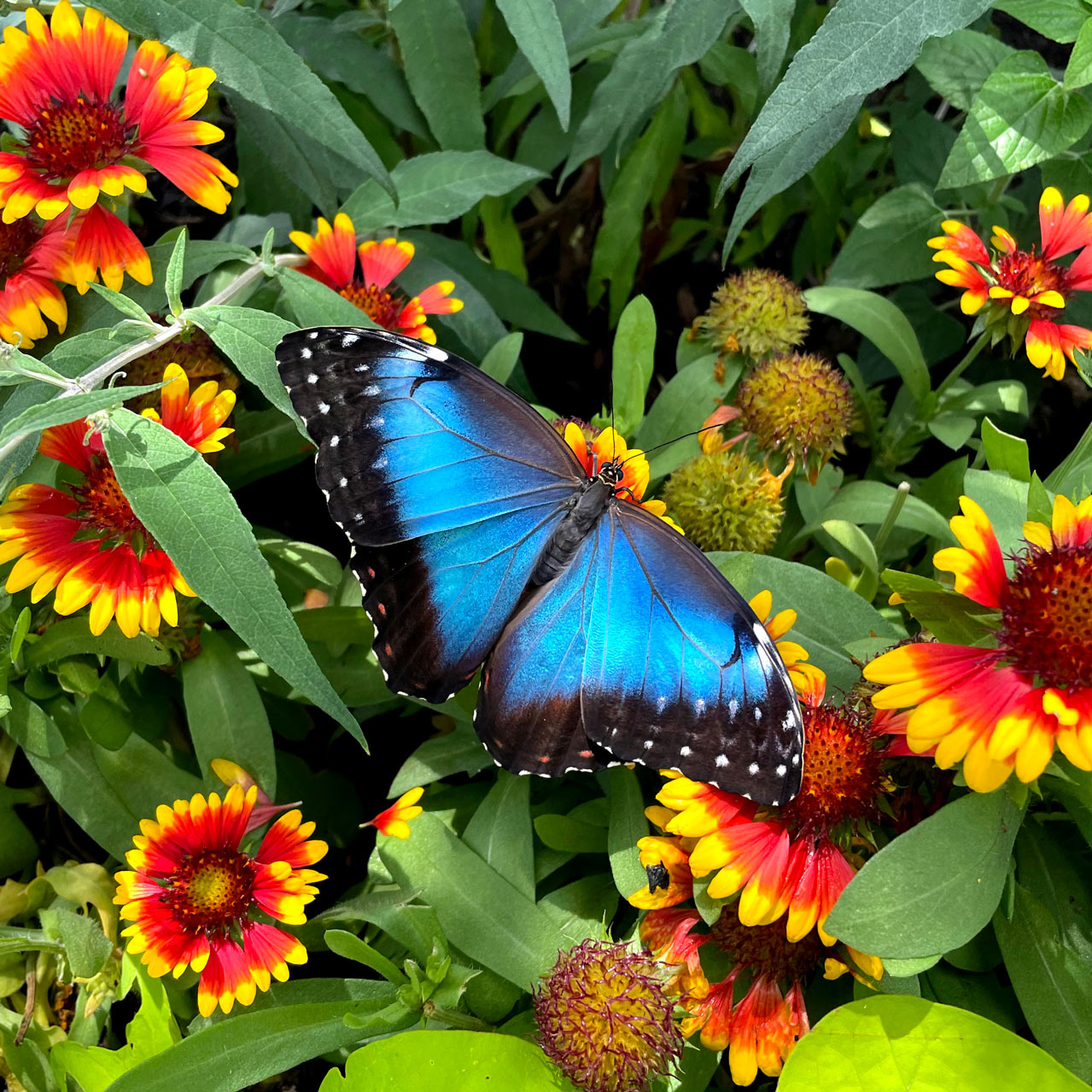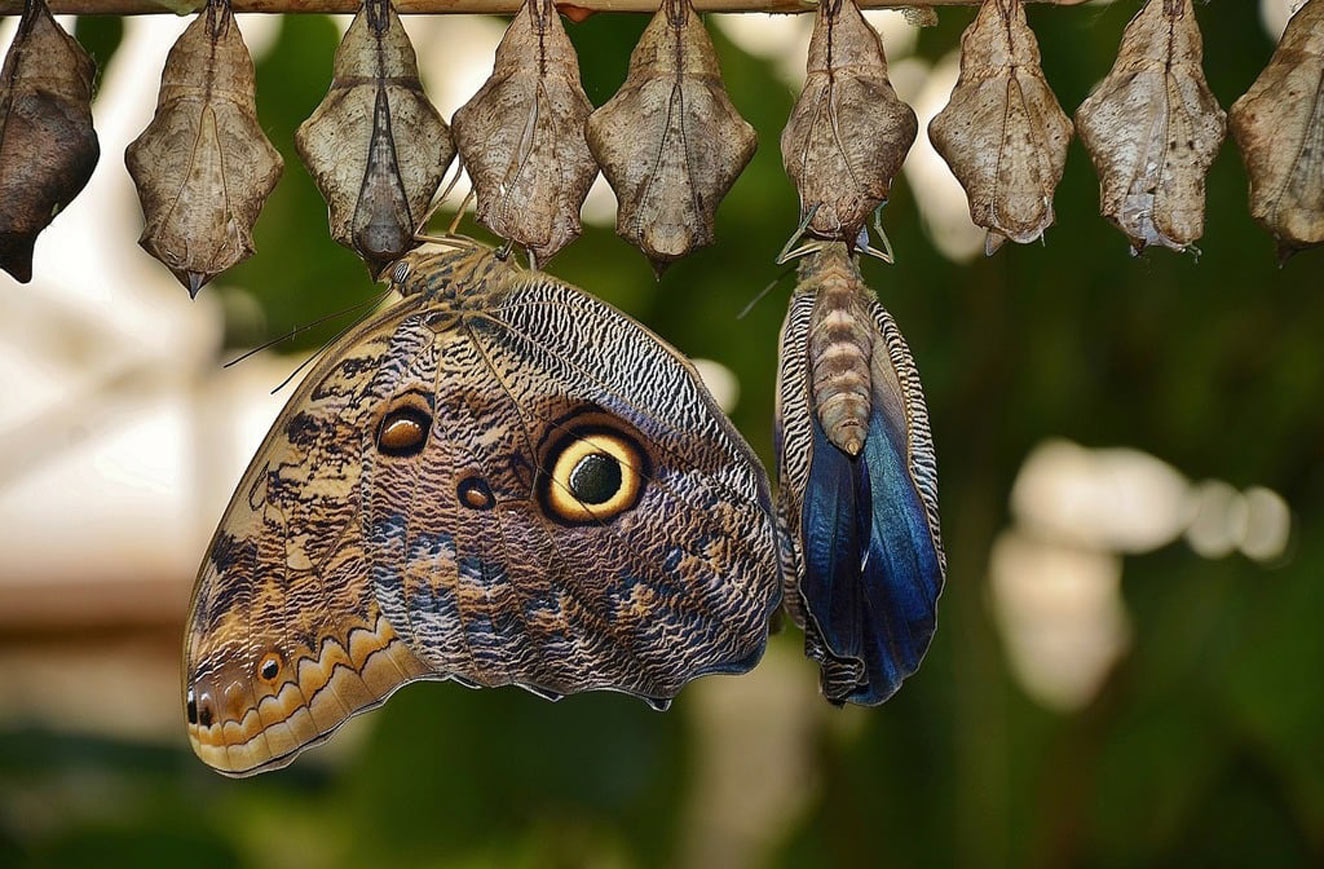The Blue Morpho butterfly, scientifically known as Morpho menelaus, is one of the most stunning and recognizable butterflies in the world. Its iridescent blue wings capture the imagination and evoke a sense of wonder. Come to The Butterfly House at Navy Pier in Chicago to see them for yourself!
Life Cycle of the Blue Morpho Butterfly
The Blue Morpho butterfly undergoes a complete metamorphosis, which includes four stages: egg, larva (caterpillar), pupa (chrysalis), and adult.
- Egg: The female Blue Morpho lays her eggs on the underside of host plant leaves, often on species such as pea plants. These tiny, green eggs are usually laid singly to reduce the chances of predation.
- Larva (Caterpillar): Upon hatching, the caterpillar begins its voracious feeding on the host plant leaves. The caterpillars of Blue Morpho butterflies are notable for their reddish-brown color and white patches. They also possess urticating hairs (bristles) that can irritate predators and provide some defense.
- Pupa (Chrysalis): After several molts, the caterpillar forms a chrysalis. This stage is a period of transformation, where the caterpillar undergoes remarkable changes to become an adult butterfly. The chrysalis of the Blue Morpho is green, blending well with the foliage, providing camouflage from predators.
- Adult: Emerging from the chrysalis, the adult Blue Morpho displays its brilliant blue wings. These butterflies are known for their large wingspan, which can range from 5 to 6 inches (12 to 15 cm). The upper side of the wings is an iridescent blue, while the underside is brown with eyespots, offering effective camouflage when the wings are closed.
Lifespan
The lifespan of the Blue Morpho butterfly varies depending on environmental conditions and predation pressures. Generally, the adult Blue Morpho lives for about 115 days. The entire life cycle from egg to adult can take about 115 days as well, but this can vary with temperature and other environmental factors.
Diet
The diet of the Blue Morpho butterfly changes as it progresses through its life stages.
- Caterpillars: In the larval stage, Blue Morpho caterpillars feed on the leaves of their host plants, which typically include various species of pea plants and other legumes.
- Adults: Adult Blue Morpho butterflies feed primarily on the juices from rotting fruits. They use their proboscis, a long, tube-like mouthpart, to suck up the fermenting juices. They are also known to sip on tree sap, fungi, and decomposing animals to obtain nutrients.

Habitat and Distribution
Blue Morpho butterflies are native to the tropical forests of Central and South America. They are commonly found in countries like Brazil, Venezuela, Costa Rica, and Ecuador. These butterflies prefer the lowland rainforests but can also be seen in secondary forests and other wooded areas.
In their natural habitat, Blue Morpho butterflies spend most of their time in the forest canopy, where they are safe from many ground predators. However, they do come down to the forest floor to feed on rotting fruits and other food sources.
Behavior and Adaptations
The Blue Morpho butterfly has several fascinating behaviors and adaptations that contribute to its survival.
- Camouflage: The underside of the Blue Morpho’s wings is brown with eye spots, which helps it blend into the surroundings and evade predators when its wings are closed.
- Flight: Blue Morpho butterflies are strong fliers and are known for their slow, erratic flight patterns. This can make it difficult for predators to catch them. Additionally, the flash of blue from their wings when they fly can startle and confuse predators.
- Mimicry and Warning: The iridescent blue of their wings is not due to pigmentation but rather structural coloration. The microscopic scales on their wings reflect light in such a way that it creates the vivid blue color. This dazzling display can also serve as a warning signal to potential predators about their unpalatable taste.
Conservation
While the Blue Morpho butterfly is not currently listed as endangered, its habitat is under threat due to deforestation and habitat fragmentation in the tropical rainforests. Conservation efforts are crucial to preserving these magnificent butterflies and their natural habitats. Organizations and researchers are working to promote sustainable practices and protect the rainforests that Blue Morphos call home.
Conclusion
The Blue Morpho butterfly is a true marvel of nature, with its striking blue wings and fascinating life cycle. From its beginnings as a tiny egg to its transformation into a stunning butterfly, the Blue Morpho captivates all who have the chance to observe it. Understanding the life and habits of these butterflies not only enriches our appreciation for them but also highlights the importance of conserving their tropical habitats. Whether you encounter them in the wild or in The Butterfly House at Navy Pier in Chicago, the Blue Morpho butterfly is sure to leave a lasting impression!





